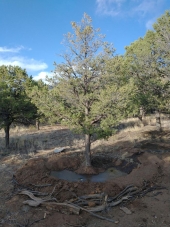





 1
1





 1
1




Moderator, Treatment Free Beekeepers group on Facebook.
https://www.facebook.com/groups/treatmentfreebeekeepers/





 1
1




replace it with water-efficient landscaping using drip irrigation
No, this program requires plants and drip irrigation to be installed. This rule is in place to follow local city ordinances.
Invasive plants are Earth's way of insisting we notice her medicines. Stephen Herrod Buhner
Everyone learns what works by learning what doesn't work. Stephen Herrod Buhner




I make a Maple Syrup instructional movie! Check it out HERE
SKIP books, get 'em while they're hot!!! Skills to Inherit Property
See me in a movie building a massive wood staircase:Low Tech Lab Movie




 1
1




Gray Henon wrote:You might check to see what the emerald ash borer predictions are in your area. If they are bad, it might be best to go ahead and replace the tree with a different species.
 1
1




Michael Cox wrote:I find that a very strange proposal. Why are they paying you to remove grass?
What are you planning to have there instead?




Anne Miller wrote:Jae, thank you for sharing about "Flip your Strip" as it looks like several cities are adopting the idea.
As for your tree roots, I don't like to disturb tree roots that are close to the trunk. Maybe you could hide the roots under wood chips rather than remove them.
I hope you will share a little more about what your plans are.
replace it with water-efficient landscaping using drip irrigation
https://jvwcd.org/file/21deb524-b059-49ab-afd5-22e7bc42bb88/Flip-Your-Strip-Program.pdf
And this one:
No, this program requires plants and drip irrigation to be installed. This rule is in place to follow local city ordinances.
https://utahwatersavers.com/Program/2/flip-your-strip
 1
1




Mike Haasl wrote:Has that strip been irrigated in the past? That might explain if the reason behind lots of surface roots. Is the mulch going to be wood chips? I hope so... Can you just leave the root area alone and cover with chips or would it be too high? Digging out 3" around a tree in an irrigated yard might damage it.
Could you put in a dainty retaining wall just above the curb to allow for adding mulch without digging?




calbo collier wrote:I'm sorry Jae. Referring to the WesternGarden book on the shelf - Perhaps the root-store was not damaged, and only the root-tips-feed area is damaged. Not a great situation, but the root-store might keep the tree thriving through the summer and autumn. Anyway, if you have the WesternGarden book, I'm looking at the "basic planting and care" section, "how plants grow" subsection.
And along the lines of this project, I live in a city where the city "owns" the trees on the verge, but I am responsible for the sidewalk being smooth and flat. I cannot prune, or touch the tree. Should the city's trees damage the pavement, I have the honor of paying at least 50% of repairs. After some 10 years of repeated damage, I have the honor of paying for the removal of the city tree! And now the kicker - the contractor the city use to "repair" the pavement just cut the root-tips area - just whack away at them, literally - no concern at all for the health of the tree. Ugh.

 1
1




Creating sustainable life, beauty & food (with lots of kids and fun)






|
Nothing? Or something? Like this tiny ad:
Learn Permaculture through a little hard work
https://wheaton-labs.com/bootcamp
|





